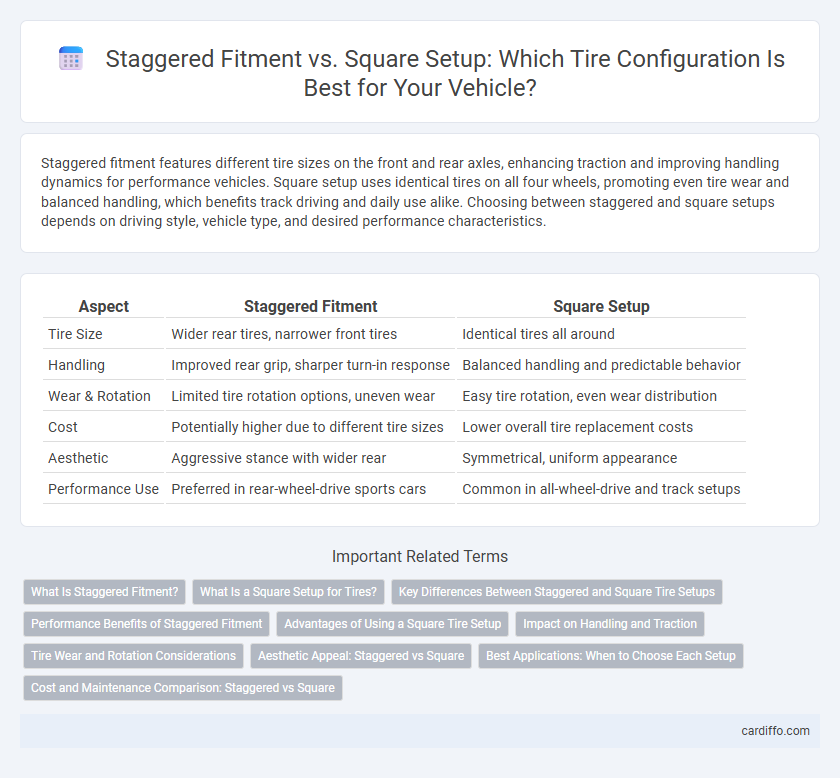Staggered fitment features different tire sizes on the front and rear axles, enhancing traction and improving handling dynamics for performance vehicles. Square setup uses identical tires on all four wheels, promoting even tire wear and balanced handling, which benefits track driving and daily use alike. Choosing between staggered and square setups depends on driving style, vehicle type, and desired performance characteristics.
Table of Comparison
| Aspect | Staggered Fitment | Square Setup |
|---|---|---|
| Tire Size | Wider rear tires, narrower front tires | Identical tires all around |
| Handling | Improved rear grip, sharper turn-in response | Balanced handling and predictable behavior |
| Wear & Rotation | Limited tire rotation options, uneven wear | Easy tire rotation, even wear distribution |
| Cost | Potentially higher due to different tire sizes | Lower overall tire replacement costs |
| Aesthetic | Aggressive stance with wider rear | Symmetrical, uniform appearance |
| Performance Use | Preferred in rear-wheel-drive sports cars | Common in all-wheel-drive and track setups |
What Is Staggered Fitment?
Staggered fitment refers to a tire setup where the front and rear tires differ in size, often with wider rear tires for improved traction and handling, particularly in performance vehicles. This configuration enhances cornering stability and aggressive styling by accommodating larger rear wheels compared to the front. Staggered fitment contrasts with a square setup, where all four tires have identical dimensions for balanced wear and easier rotation.
What Is a Square Setup for Tires?
A square setup for tires means all four wheels have the same tire size and width, promoting uniform handling and easier rotation patterns. This configuration enhances consistent traction and balanced wear, especially beneficial for daily driving and light performance vehicles. Manufacturers often recommend square setups to maintain predictable vehicle dynamics and simplify maintenance.
Key Differences Between Staggered and Square Tire Setups
Staggered tire setups feature different sizes on the front and rear axles, with wider tires typically on the rear for enhanced traction and aggressive handling, often preferred in performance and rear-wheel-drive vehicles. Square setups use identical tire sizes on all four wheels, promoting even tire wear, simplified rotation, and balanced handling, making them ideal for all-wheel-drive systems and improved straight-line stability. The choice impacts grip, aesthetics, and maintenance, with staggered fitments favoring cornering performance and square setups offering versatility and cost-effectiveness.
Performance Benefits of Staggered Fitment
Staggered fitment, featuring wider tires at the rear than the front, enhances traction and stability during high-performance driving by optimizing grip in acceleration and cornering. This setup improves handling dynamics, especially for rear-wheel-drive vehicles, by reducing understeer and increasing rear-end grip. Performance benefits include better power distribution and a more aggressive stance that contributes to improved aerodynamics and vehicle balance.
Advantages of Using a Square Tire Setup
A square tire setup, with matching tires and wheels on all four corners, enhances predictable handling and balanced traction, especially on performance vehicles. This configuration promotes even tire wear, extending tire life and reducing maintenance costs. Improved stability during cornering and braking makes square fitment ideal for both road and track applications, delivering consistent performance across various driving conditions.
Impact on Handling and Traction
Staggered fitment, featuring larger rear tires and smaller front tires, enhances rear traction and stability during acceleration, improving handling in high-performance rear-wheel-drive vehicles. Square setups, with uniform tire sizes on all wheels, offer balanced grip and predictable handling, beneficial for all-wheel-drive cars and neutral cornering. This configuration promotes even tire wear and consistent traction across all wheels, optimizing overall driving dynamics.
Tire Wear and Rotation Considerations
Staggered fitment, with different tire sizes on the front and rear, often leads to uneven tire wear patterns due to varying traction and pressure distribution, requiring careful monitoring and less flexible rotation options. Square setups use identical tires on all four corners, promoting even tire wear and simpler tire rotation schedules that extend tire life and maintain balanced handling. Understanding these wear and rotation dynamics is critical for optimizing performance, safety, and tire longevity in performance and daily-driving vehicles.
Aesthetic Appeal: Staggered vs Square
Staggered fitment enhances a vehicle's aesthetic appeal by pairing wider tires on the rear axle with narrower tires upfront, creating an aggressive, performance-oriented stance favored in sports and luxury cars. Square setups, where all four tires are the same size, contribute to a balanced and symmetrical look that appeals to enthusiasts seeking consistency and simplicity. The choice between staggered and square tire configurations significantly impacts visual dynamics, with staggered setups emphasizing boldness and square setups offering sleek uniformity.
Best Applications: When to Choose Each Setup
Staggered fitment, with different tire sizes on front and rear axles, is best suited for high-performance sports cars requiring enhanced rear grip and aggressive handling dynamics. Square setups, using identical tire sizes on all wheels, provide balanced wear, easier rotation, and improved traction ideal for daily driving and all-wheel-drive vehicles. Choosing between the two depends on vehicle drivetrain, intended use, and handling preferences, with staggered fitment favoring rear-wheel-drive performance cars and square setups benefiting balanced, versatile performance.
Cost and Maintenance Comparison: Staggered vs Square
Staggered fitment, featuring different tire sizes on the front and rear, typically incurs higher costs due to the need for specialized tires and limited rotation options, leading to uneven tire wear and increased maintenance expenses. Square setups use identical tires on all four wheels, allowing for regular rotation that extends tire life and reduces replacement frequency, resulting in lower overall maintenance costs. Choosing a square setup optimizes budget efficiency by minimizing tire expenses and simplifying upkeep compared to the more costly and maintenance-intensive staggered fitment.
Staggered fitment vs Square setup Infographic

 cardiffo.com
cardiffo.com